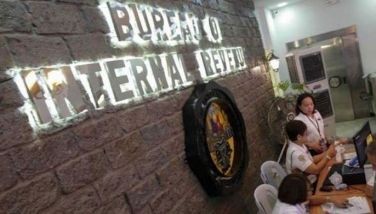Economic deja vu?
August 21, 2006 | 12:00am
Consider the following scenario:
• rising oil prices, tension and conflict in the Middle East, an erupting volcano,
• the country still reeling from the impact of a coup attempt, the President struggling to get a supplemental budget bill and other reform measures approved in Congress, and
• the government embarking on an ambitious endeavour to spur growth regions around the country.
Present day Philippines? Maybe. But the same also characterized the Philippines circa-1991 although the situation then was a lot worse. The country suffered from massive devastation and economic displacement following the 1990 earthquake, the 1991 Mt. Pinatubo eruption and the abrogation of the US military bases treaty. Today, we are in far better shape with the government successfully licking a fiscal crisis problem. Despite initial hesitation by Congress, definitive fiscal reforms are finally in place and are yielding results that has emboldened government to pursue a more ambitious and massive infrastructure development.
We are drawing a parallelism between our situation now and in 1991 to show how far we have gone despite what current day doomsayers would tell you. We are definitely not in an economic deja vu.
We mentioned last week how President Arroyo and Finance Secretary Margarito Teves took the legislative lead in sowing the seeds of economic reforms in the 1990s. Today, we think that more space can be allocated to expound on their role in the country’s economic recovery. This is not meant to patronize them. We just would like to dig deeper on their qualifications and experience especially amid a pervasive skepticism on the viability of the so-called SONA projects. We are doing this just as a company would evaluate the resume of an individual who would be hired to perform a certain job.
We know that the most crucial tasks pertaining to the implementation of the SONA projects rest on the shoulders of President Arroyo and Finance Secretary Teves. But are they fit for the job? Do they have sufficient experience? Can we really raise enough funds to finance these projects?
Let us begin with Congressman Teves. In his three congressional terms, he was considered the economist of the Lower House, being the chairman of the committee on economic affairs for several terms. He was responsible for initiating the most crucial measures pertaining to economic reforms. Among the significant measures he initiated and co-authored are the following:
• the landmark Foreign Investments Act
• the Export Development Act
• Magna Carta for Small Enterprises
• various tax reform measures
• the act that restructure and strengthened the central bank
• the act liberalizing the entry of foreign investors to the banking industry
• the landmark Build-Operate-Transfer Act
• the act creating the Cooperative Development Authority
If we take a look at the profile of these measures, they cover a very comprehensive approach to economic development – national to rural in scope, and economic and fiscal in nature. It is also interesting to note that these laws came into being despite Congress’ hesitance to go against the "nationalistic" tide prevalent a decade ago. Ironically, we are attributing today much of our progress to the passage of these reform measures. It is just as comforting to note, too, that Mr. Teves became the House chairman on rural development committee and eventually became the president of the Land Bank of the Philippines. This should have provided him a better perspective on rural realities and development needs.
The case of the then Trade Undersecretary Arroyo is just as interesting. If we remember correctly, she was the point-person in promoting the creation of regional industrial centers (RICs) and export processing zones around the country. This was her pet project, so to speak. But her job was not made easy given the flak the country was then getting from investors due to its rebellious military and being the "natural disaster" capital of the region.
Through the creation of RICs, government finally initiated the industrialization of areas outside Metro Manila. RICs were chosen based on their strong industrial potential and their fairly developed and adequate infrastructure and utilities. With this strategy, industries were brought closer to sources of raw materials and labor. About 18 RICs were established in the country’s then 14 regions.
In 1991, investors were shying away from the Philippines. However, with proper and focused promotion, the RICs were eventually regarded as safe havens for investments and industries notwithstanding the general uncertainties in the country. That is why Cebu boomed and an industrialized CALABARZON came about. Today, there are almost 1,100 company locators in the economic zones alone. Data from the Philippine Economic Zone Authority also show an encouraging picture, as follows:
• cumulative investments between 1995-2005 at P935.7 billion is 38x the level in 1984-1994
• employment rose by about 5x from just 230,000 in 1994 to 1.13 million last year
• ecozone exports grew almost 12x from $2.74bn in 1994 to $32bn last year
As a senator, Mrs. Arroyo was also in the forefront of pushing for economic reforms. In many cases, she was the counterpart of Mr. Teves in the Senate in pushing for the passage of the various investment bills, the Export Development Act, the amended BOT law, the foreign bank liberalization act and the law providing for economic safety nets when the country joined the world trade agreement.
What Mrs. Arroyo and Mr. Teves have in common is their ability to focus and their firm grasp on what needs to be done. Through the years, they exhibited capability to remain unperturbed by how dire the circumstances may be or discouraged by what doomsayers have to say. This speaks of their self-confidence borne out of experience and knowledge. More importantly, both were involved in strategy formulation and implementation at various levels. Another reassurance that they can offer us is that they have a keen appreciation of both national and local needs. They are not some technocrats fresh from school and acquired their positions by mere political patronage.
Given these qualifications of the country’s CEO and CFO, the SONA projects are in capable hands. Such endeavours stand a good chance of having the economic benefits directly felt (not just in trickles) in the various regions of the country.
Come to think of it. The creation of the so-called super regions is actually an expansion of the RIC strategy. Only this time, it has a more comprehensive approach. The super region strategy goes further to group provinces or regions (and not just a choice city or town) according to their distinct strengths and resources. It is therefore a more focused approach than the seemingly shotgun approach that the previous programs adopted. Furthermore, President Arroyo’s managers seem to have employed a basic concept in competitive strategy wherein strengths and weaknesses are matched against opportunities and threats.
One more important aspect of the new strategy is the infrastructure component. Surely, the P372-billion tag price appears massive and this has created all the skepticism among Filipinos. But what we deem more important is that, after all the fiscal reforms that we have implemented, the country is in a better financial shape to pursue these projects. We should be more worried if the government’s financial gains were just locked up somewhere and not put into efficient use for the benefit of the entire country. Let us also factor in the prudence of the "unpoliticized" Mr. Teves.
At any rate, the projects will not depend solely on government for financing. They were envisioned to be partly financed by contributions from GOCCs and local government units as well from the private sector through B-O-T arrangements.
But what we are underestimating here is the potential of such projects to be self-sustaining. We might not need to complete all the projects before starting to experience the economic benefits. We might also be underestimating the multiplier effects of construction (at a massive scale at that) on employment, purchasing power and spurring economic activities on the local level. All these could eventually attract private companies to put up shops and plants in these areas given the newfound accessibility and improved prospects in these regions. The heightened economic activities would mean more revenues for the government that can be used to pursue the other components of the program. Given all these factors and all the possibilities, we can afford to have a little faith in ourselves.
• rising oil prices, tension and conflict in the Middle East, an erupting volcano,
• the country still reeling from the impact of a coup attempt, the President struggling to get a supplemental budget bill and other reform measures approved in Congress, and
• the government embarking on an ambitious endeavour to spur growth regions around the country.
Present day Philippines? Maybe. But the same also characterized the Philippines circa-1991 although the situation then was a lot worse. The country suffered from massive devastation and economic displacement following the 1990 earthquake, the 1991 Mt. Pinatubo eruption and the abrogation of the US military bases treaty. Today, we are in far better shape with the government successfully licking a fiscal crisis problem. Despite initial hesitation by Congress, definitive fiscal reforms are finally in place and are yielding results that has emboldened government to pursue a more ambitious and massive infrastructure development.
We are drawing a parallelism between our situation now and in 1991 to show how far we have gone despite what current day doomsayers would tell you. We are definitely not in an economic deja vu.
We know that the most crucial tasks pertaining to the implementation of the SONA projects rest on the shoulders of President Arroyo and Finance Secretary Teves. But are they fit for the job? Do they have sufficient experience? Can we really raise enough funds to finance these projects?
• the landmark Foreign Investments Act
• the Export Development Act
• Magna Carta for Small Enterprises
• various tax reform measures
• the act that restructure and strengthened the central bank
• the act liberalizing the entry of foreign investors to the banking industry
• the landmark Build-Operate-Transfer Act
• the act creating the Cooperative Development Authority
If we take a look at the profile of these measures, they cover a very comprehensive approach to economic development – national to rural in scope, and economic and fiscal in nature. It is also interesting to note that these laws came into being despite Congress’ hesitance to go against the "nationalistic" tide prevalent a decade ago. Ironically, we are attributing today much of our progress to the passage of these reform measures. It is just as comforting to note, too, that Mr. Teves became the House chairman on rural development committee and eventually became the president of the Land Bank of the Philippines. This should have provided him a better perspective on rural realities and development needs.
Through the creation of RICs, government finally initiated the industrialization of areas outside Metro Manila. RICs were chosen based on their strong industrial potential and their fairly developed and adequate infrastructure and utilities. With this strategy, industries were brought closer to sources of raw materials and labor. About 18 RICs were established in the country’s then 14 regions.
In 1991, investors were shying away from the Philippines. However, with proper and focused promotion, the RICs were eventually regarded as safe havens for investments and industries notwithstanding the general uncertainties in the country. That is why Cebu boomed and an industrialized CALABARZON came about. Today, there are almost 1,100 company locators in the economic zones alone. Data from the Philippine Economic Zone Authority also show an encouraging picture, as follows:
• cumulative investments between 1995-2005 at P935.7 billion is 38x the level in 1984-1994
• employment rose by about 5x from just 230,000 in 1994 to 1.13 million last year
• ecozone exports grew almost 12x from $2.74bn in 1994 to $32bn last year
As a senator, Mrs. Arroyo was also in the forefront of pushing for economic reforms. In many cases, she was the counterpart of Mr. Teves in the Senate in pushing for the passage of the various investment bills, the Export Development Act, the amended BOT law, the foreign bank liberalization act and the law providing for economic safety nets when the country joined the world trade agreement.
Given these qualifications of the country’s CEO and CFO, the SONA projects are in capable hands. Such endeavours stand a good chance of having the economic benefits directly felt (not just in trickles) in the various regions of the country.
Come to think of it. The creation of the so-called super regions is actually an expansion of the RIC strategy. Only this time, it has a more comprehensive approach. The super region strategy goes further to group provinces or regions (and not just a choice city or town) according to their distinct strengths and resources. It is therefore a more focused approach than the seemingly shotgun approach that the previous programs adopted. Furthermore, President Arroyo’s managers seem to have employed a basic concept in competitive strategy wherein strengths and weaknesses are matched against opportunities and threats.
At any rate, the projects will not depend solely on government for financing. They were envisioned to be partly financed by contributions from GOCCs and local government units as well from the private sector through B-O-T arrangements.
But what we are underestimating here is the potential of such projects to be self-sustaining. We might not need to complete all the projects before starting to experience the economic benefits. We might also be underestimating the multiplier effects of construction (at a massive scale at that) on employment, purchasing power and spurring economic activities on the local level. All these could eventually attract private companies to put up shops and plants in these areas given the newfound accessibility and improved prospects in these regions. The heightened economic activities would mean more revenues for the government that can be used to pursue the other components of the program. Given all these factors and all the possibilities, we can afford to have a little faith in ourselves.
BrandSpace Articles
<
>
- Latest
- Trending
Trending
Latest
Trending
Latest
Recommended




























